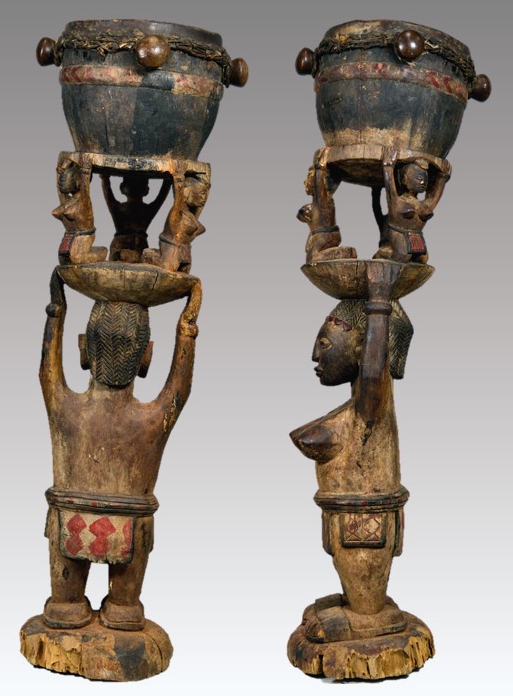A-ndëf
Not on view
The a-ndëf (also te-ndëf) is a caryatid drum found in the music-making traditions of the Baga, an ethnic group in western Guinea. It is associated with a-tëkän, the Baga institution for female solidarity, and is played at various events of importance to women. The form of the instrument–specifically, the depiction of a female figure supporting a globular object on her head–is common to Baga drums. It is also evocative of Baga women’s roles in society. Not only do women carry large clay water vessels or baskets for food, notably rice, on their heads, “[w]omen are the bearers of Baga society in every sense of the world,” art historian Frederick Lamp explains (1996: 124).
According to Lamp, the a-tëkän, whose membership is typically exclusive to mothers, is one of the most enduring ritual institutions of the Baga (ibid: 122). A-tëkän performances, which consist of a group of drummers and a circle of dancers, take place at weddings or funerals of important women elders, among other events. Dance is frequently accompanied with songs with lyrics that relate to universal problems of mothers.
This a-ndëf is carved from a single piece of wood. At the top, it is encircled by a snake, which is a reference to the serpent spirit in Baga society, and likely meant to symbolize fertility as well. The standing female figure at the base of the instrument has her arms raised to balance a bowl-shaped disk above her head, on which three equally-spaced kneeling women–an act of devotion in Baga society–also have their hands raised to balance another horizontal disk on which the drum is positioned. The female figure at the base is wearing sandals, an incised and painted skirt, a belt, jewelry and a crown. This accoutrement mirrors that of brides, who, as part of marriage rituals, typically perform a dance in which they carry baskets on their heads into which onlookers throw gifts; specifically, money and grains of rice.
The Baga are what some anthropologists call “acephalous,” which means they do not have a historical state or kingdom. The Baga migrated westward from their ancestral home in Futa Jalon in present-day central Guinea to the western coast of Guinea, where their presence was first documented in the sixteenth century, in order to resist Islamic conversion. “Once on the coast,” Lamp writes, “the Baga ‘invented’ or ‘discovered,’ they claim, an impressive variety of both spiritual beings and spiritual ‘ideas,’” around which their cultural traditions are organized (1996: 19).
Baga spirits tend to be separated by gender: a male spirit, often taking the form of a serpent or bird; and a female spirit, sometimes taking the form of a sea turtle. Baga drums are also separated by gender. The a-ndëf, in particular, is associated with the feminine. This gender division is not meant to be rigid, but rather “inclusive and interconnected in nature,” Lamp writes (ibid: 25). Accordingly, the a-ndëf may, on certain occasions, be played by a man. During the masquerade of a-Bol, a female spirit, for example, men crossdress and play the a-ndëf. The a-ndëf’s masculine counterpart, the larger timba, however, is played exclusively by men (for an example in the Met’s collection see accession no. 2003.316).
Throughout the twentieth century, the Baga people and their traditions were violently suppressed. First, “during colonial occupation by the French,” Lamp explains, “the demand for African art objects in France nearly denuded the Baga cultural landscape of old masks and ritual sculpture” (ibid: 19). A few years shy of Guinean independence, from 1956-7, Malinke and Susu Muslim missionaries raided villages, cut down sacred forests, and tortured opponents to Islamic conversion in the Baga territory, with the blessing of then-dictator Sékou Touré (ibid: 21). After Touré took power, traditional religious practices were declared illegal and were severely punished. In recent years, however, certain Baga rituals have been revived, owing, in part, to the interest generated by displays of their cultural heritage in Western museums. (Althea SullyCole, 2022)
References:
Lamp, Frederick. 1996. Art of the Baga. New York: Museum of African Art.
Due to rights restrictions, this image cannot be enlarged, viewed at full screen, or downloaded.
This artwork is meant to be viewed from right to left. Scroll left to view more.



